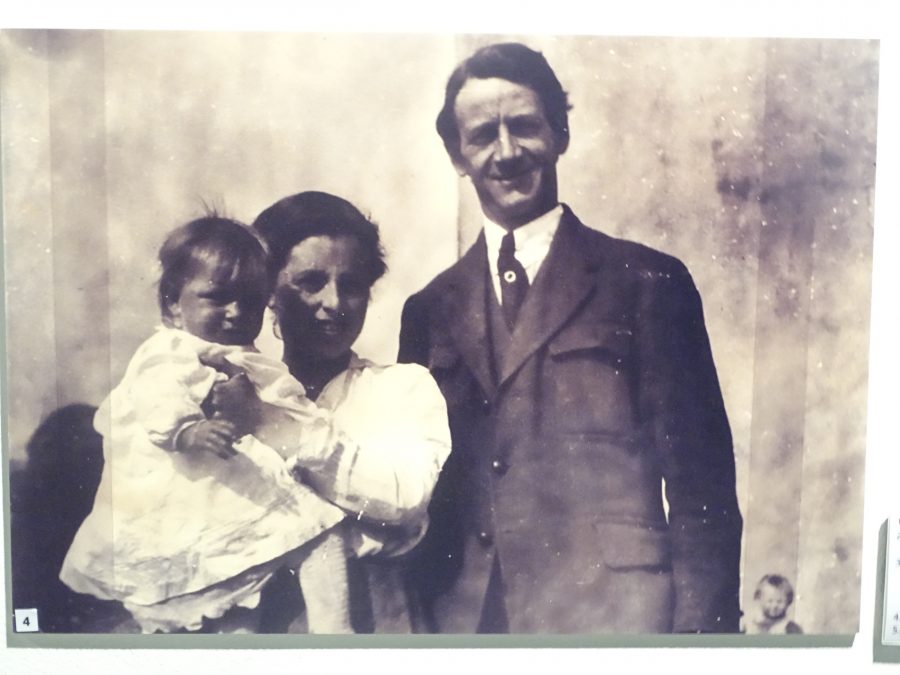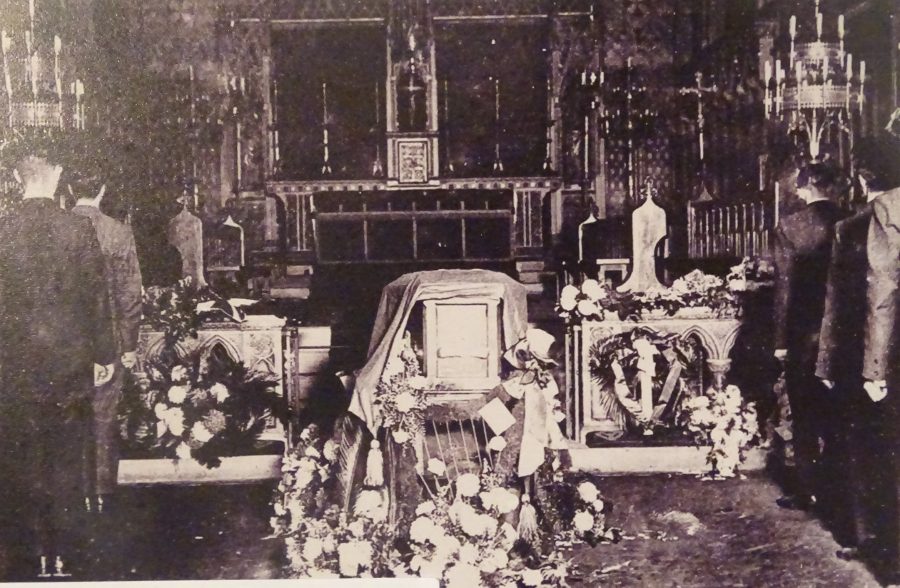
1071a. Terence, Muriel and Máire MacSwiney, c.1920 (source: Cork City Library).
Kieran’s Our City, Our Town Article,
Cork Independent, 22 October 2020
Remembering 1920: The Death of Terence MacSwiney
Monday 18 October 1920 coincided with day 67 of Terence MacSwiney’s hunger strike in London’s Brixton Prison, and the continued deterioration of his health. The diary of his sister Annie recalls that he was conscious when she was with him from early that morning till lunchtime. Three prison doctors Peddard, Griffith, Hijson visited him at 1pm. They were with him some time, and when they left the room, they spoke to Terence’s wife Muriel. Dr Griffith was adamant that he should take some food. Dr Peddard told her Terence was developing scurvy and should take lime juice to ward it off. Muriel refused to give permission as did other family members.
Over the ensuing days, Terence would waiver in and out of consciousness and become delirious. Sometimes he tried to get out of bed. Sometimes he struggled into sitting posture. In his emaciated condition everything was difficult. Insistence by the doctors to take some food led to further delirium of Terence and anger by his family members (brothers Peter and Seán, and sisters Mary and Annie) who visited him and championed his hunger strike position. Whatever was given was quickly vomited up as his condition faded. Daily British and Irish newspapers such as the Cork Examiner carried news of his ordeal and pictures of family figures and friends of the Republican cause coming and going from the gaol. There is tiredness and concern in their eyes. Further afield public meetings were held as far away such as France and Germany with other countries requesting his release.
At 5.40am on Monday 25 October 1920 or day 74 of Terence’s hunger strike the advent of his expected death occurred. The immediate 48 hours, which followed, were recorded in detail by his sister Annie in her diary account. It provides much detail into the emotion of being present, the grief, the confusion but above all her and her siblings’ reaction to Westminster’s Home Office and the policing authorities.
A short few hours after his death, Terence’s inquest was fixed for 11am. Present were siblings as well as Fr Dominic, Florence McCarthy (Town Clerk of Cork, William Hegarty (Lord Mayor’s secretary), and Donal J Galvin (Cork City Solicitor). Terence’s wife Muriel was served with a notice by the prison authorities to appear to identify the body, but the policing authorities seemed rather anxious that she should not appear. Defiantly but also traumatised she walked past the plethora of photographers at the prison gate, appeared in a dark veil and answered in short sentences to the questions before Coroner Dr G P Wyatt and the sworn in jury from the Brixton area. Muriel became animated in her intervention when she described that Terence was a soldier of the Irish Republican Army and that his occupation was to work for his country. Sometime later, in his summing up to the jury the Coroner asked of the jury three questions – did MacSwiney deliberately take his own life, did refusing food unbalance his mind that he was not clearly thinking or was he hoping that the hunger strike would lead to his release? The verdict of the inquest read; “The deceased died from heart failure consequent upon his refusal to take food”.
When the inquest was over, Mr James Heyman McDonnell, the family solicitor, asked for the certificate that would give Terence’s body into the family’s keeping. This was when further red tape were presented to the family. The Coroner argued that he had no power to give release of the body for burial outside England. Mr McDonnell asked for release to Southwark Cathedral, but that, too, was refused. Eventually, it was decided that Muriel and Art O’Brien should go to the Home Office and ask for an explanation. Art was the envoy of Dáil Éireann in Britain (since 1919) and was also a leading figure in organising campaigns for the release of Irish political prisoners held in Britain and in orchestrating the publicity campaign surrounding the hunger-strike of Terence.
At the home office Mr McDonnell was informed that a government vessel would he placed at the family’s disposal, free of all expense, and every facility offered if they went straight to Cork. Muriel was quiet upset by this political call wishing for her husband to get a national commemoration in Dublin. Going straight to Mr Edward Shortt, English Secretary of State for Home Affairs, she made her case and asked for her husband’s body without restrictions.
A short time late Mr Shortt sent a special message to Muriel expressing his view and regret at any delay, and assuring her that he merely wished to find out how he stood, and expressing the perspective that he was not sure of his legal powers. He had attended the Home Office and got clearance to have Terence’s body handed over to the family without restrictions. Terence’s body was then taken from Brixton Prison to the historic St George’s Southwark Cathedral in Bankside on London’s south of the Thames. At that point thousands of people had come out to line the street as the funeral carriage passed and more were present at the Cathedral. The coffin was shouldered into the church by six members of Cork Corporation. A 21 member delegation had travelled to London with members of the Cork Harbour Board to accompany their mayor home. The coffin on its catafalque was ringed by the Volunteers forming a sentry over their colleague for the night. On the coffin was an Irish inscription, which was translated as “Murdered by the Foreigner in Brixton Prison, London, England on October 25th 1920. The fourth year of the Republic. Aged 40 years. God have mercy on his soul”.
Captions:
1071a. Terence, Muriel and Máire MacSwiney, c.1920 (source: Cork City Library).
1071b. Terence’s Coffin at Southwark Cathedral, London, 25 October 1920 (source: Cork City Museum).

1071b. Terence’s Coffin at Southwark Cathedral, London, 25 October 1920 (source: Cork City Museum).